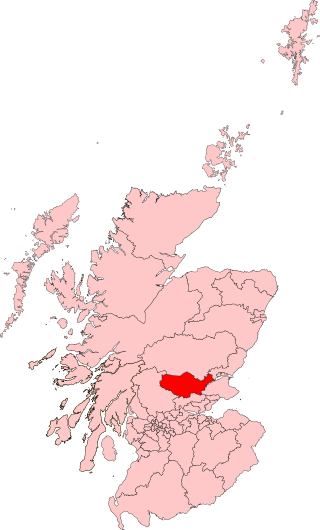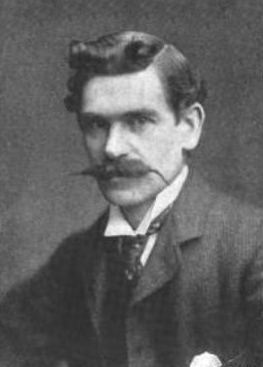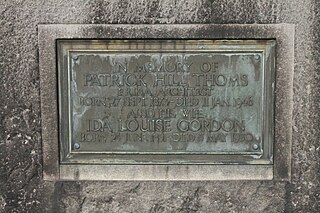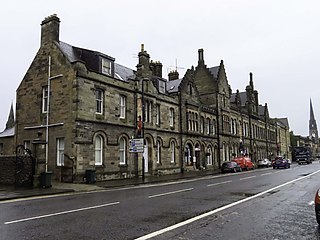
Perth is a centrally located Scottish city, on the banks of the River Tay. It is the administrative centre of Perth and Kinross council area and is the historic county town of Perthshire. It had a population of about 47,430 in 2018.

Perth was a constituency of the House of Commons of the Parliament of the United Kingdom from 1832 to 1918, 1918 to 1950, and 1997 to 2005. From 1832 to 1918 it was a burgh constituency. From 1918 to 1950, and 1997 to 2005, it was a county constituency. During each of the three periods it elected one Member of Parliament (MP).

James Miller (1860–1947) was a Scottish architect, recognised for his commercial architecture in Glasgow and for his Scottish railway stations. Notable among these are the American-influenced Union Bank building at 110–20 St Vincent Street; his 1901–1905 extensions to Glasgow Central railway station; and Wemyss Bay railway station on the Firth of Clyde. His lengthy career resulted in a wide range of building types, and, with the assistance of skilled draughtsmen such as Richard M Gunn, he adapted his designs to changing tastes and new architectural materials and technologies.

John Rhind was an architect from Inverness, Scotland.

Hippolyte Jean Blanc was a Scottish architect. Best known for his church buildings in the Gothic revival style, Blanc was also a keen antiquarian who oversaw meticulously researched restoration projects.

Sir George Washington Browne was a Scottish architect. He was born in Glasgow, and trained there and in London. He spent most of his career in Edinburgh, although his work can be found throughout Scotland and beyond. He was involved in nearly 300 projects, including many public and commercial buildings. One of his most notable buildings is Edinburgh's Central Library, and he became recognised as an authority on library planning and design. He came to national attention after winning a competition to design a bridge over the River Thames in London, although this was never realised. He was the first architect to be elected as President of the Royal Scottish Academy. He also served as President of the Edinburgh Architectural Association, and was instrumental in setting up the Royal Fine Art Commission for Scotland.
John Sage (1652–1711) was a Scottish nonjuring bishop and controversialist in the Jacobite interest.
Charles McKean FRSE FRSA FRHistS FRIBA was a Scottish historian, author and scholar.

John Murray Robertson FRIBA was a Scottish architect who did much to change Dundee.

Harold Ogle Tarbolton FRIBA (1869–1947) was a 19th/20th century British architect, mainly working in Scotland. He was affectionately known as Tarrybreeks. In later life he went into partnership with Sir Matthew Ochterlony to create Tarbolton & Ochterlony.
Charles Ower (1813–1876) and son (1849–1921) were father and son architects, operating in eastern Scotland.
James Ireland was a short-lived but productive 19th-century Scottish architect, specialising in schools.

Patrick Hill Thoms Friba Arias (1873–1946) was a 20th-century Scottish architect, based in eastern Scotland.

John Honeyman was a Scottish architect. He designed several notable buildings in Scotland, mostly churches, and worked alongside Charles Rennie Mackintosh as a partner for several years.
Tay Street is a major thoroughfare, part of the A989, in the Scottish city of Perth, Perth and Kinross. Planned in 1806 and completed around 1885, it is named for the River Tay, Scotland's longest river, on the western banks of which it sits. The street runs from the confluence of West Bridge Street and Charlotte Street in the north to a roundabout at Marshall Place and Shore Road in the south. Three of the city's four bridges that cross the Tay do so in this stretch : Perth Bridge, Queen's Bridge and the single-track Tay Viaduct, carrying Perth and Dundee trains to and from Perth railway station, located 0.5 miles (0.80 km) to the north-west.
David Smart was a Scottish architect, prominent in the second half of the 19th century. His design genre varied between municipal buildings, schools and churches, but he worked almost exclusively in Perthshire.

James Austen Laird LRIBA was an architect based in Glasgow.

62–72 Tay Street is an historic row of buildings in Perth, Scotland. Designed by local architect John Young, the building is Category B listed, dating to 1881. Standing on Tay Street, the building was originally the museum home of the Perthshire Society of Natural Science, constructed in memory of Sir Thomas Moncreiffe, 7th Baronet, a past president of the society. The museum housed two exhibits: a local collection and The Type Museum, which illustrated the main types of animals, plants and rocks.
James Smart was a Scottish architect, prominent in the first half of the 19th century. He designed several notable buildings in Perthshire, several of which are now of listed status.

Public transport in Perth and Kinross is available for two main modes of transport—bus and rail—assisting residents of and visitors to the Perth and Kinross council area to travel around much of its 2,041 square miles (5,290 km2).














